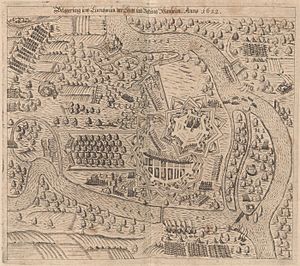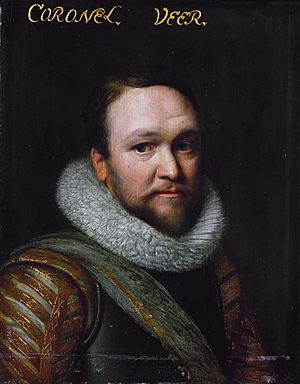Capture of Mannheim facts for kids
Quick facts for kids Capture of Mannheim |
|||||||
|---|---|---|---|---|---|---|---|
| Part of the Palatinate phase of the Thirty Years' War | |||||||
 1627 engraving of the siege |
|||||||
|
|||||||
| Belligerents | |||||||
| Commanders and leaders | |||||||
The Capture of Mannheim was a battle that happened on November 2, 1622. An army from the Empire and Spain fought against Protestant soldiers. The Imperial-Spanish army was led by Count Tilly. The Protestant troops were led by Sir Horace Vere from England. This battle was part of the Thirty Years' War.
What Led to the Battle?
In September 1620, armies from the Empire and Spain invaded a region called the Lower Palatinate. They were led by Count Tilly and Don Gonzalo Fernández de Córdoba. They took control of most of the area.
However, three important towns stayed under Protestant control. These towns were Frankenthal, Mannheim, and Heidelberg. They were defended by Protestant soldiers led by Sir Horace Vere.
On September 19, 1622, the Imperial-Spanish army won a battle at Heidelberg. They defeated the Protestant troops there, led by Sir Gerard Herbert. After this victory, the Catholic army took over the town of Heidelberg.
The Siege of Mannheim
After taking Heidelberg, the Spanish army moved towards Mannheim. The city of Mannheim was defended by soldiers from England and Germany. These troops were Protestants and were commanded by Sir Horace Vere.
Count Tilly started a siege around Mannheim. A siege is when an army surrounds a city to try and make it surrender. The Imperial-Spanish forces quickly defeated the Protestant soldiers defending the city.
The Spanish army then took control of Mannheim. Sir Vere and a few hundred of his men had to retreat to the city's strong fort, called the citadel. They had no hope of getting help or more soldiers. Because of this, Sir Vere was forced to give up and surrender.
After Mannheim fell, only Frankenthal was still held by the Protestants. It was defended by Sir John Burroughs. But about a year later, Spanish troops also captured Frankenthal.
What Happened After?

Sir Horace Vere showed great bravery during the battle, even though his side was outnumbered. People in England recognized his courage when he returned home in February 1623. Even though he wasn't fully paid for his work, he was given important new jobs.
On February 16, 1623, he became the Master-General of the Ordnance for life. This meant he was in charge of all weapons and military supplies. He also joined the Council of War on July 20, 1624. This council helped plan military actions.
In 1624, Sir Vere traveled to The Hague again. He went there to help Prince Maurice of Orange defend a very important fortress called Breda. The Spanish army, led by Don Ambrosio Spinola, was attacking Breda.
See also
 In Spanish: Captura de Mannheim para niños
In Spanish: Captura de Mannheim para niños

